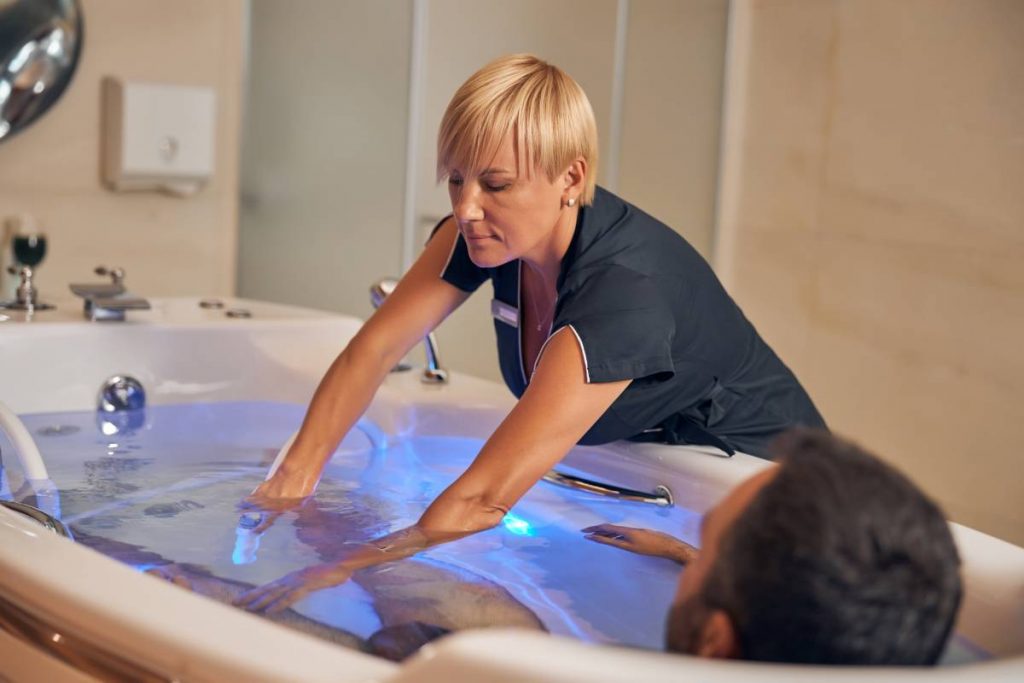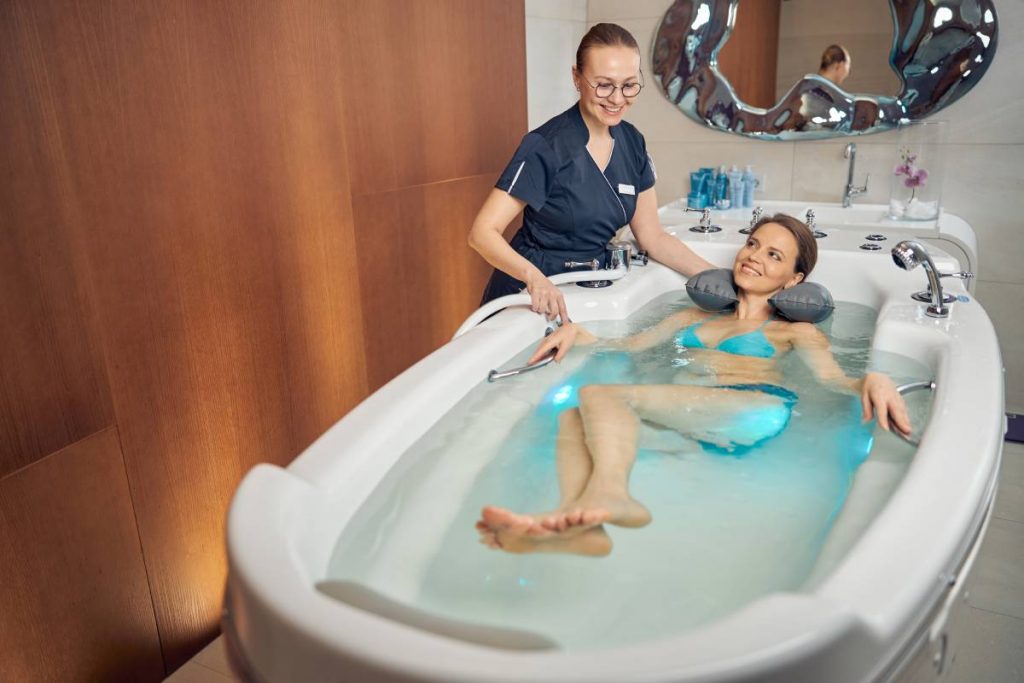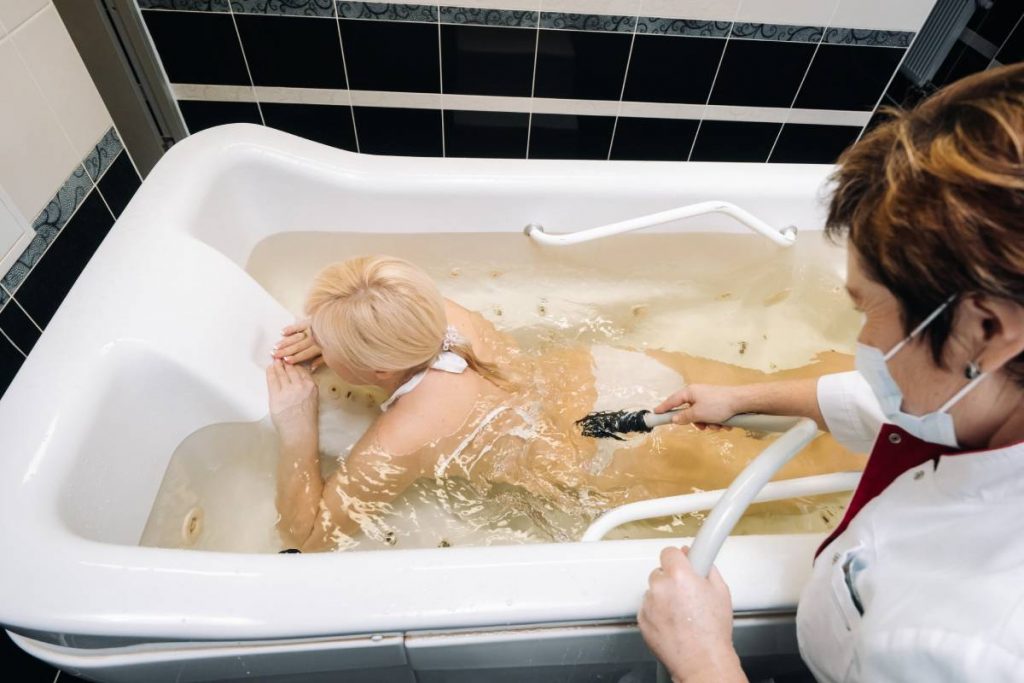Hydrotherapy has many advantages and can be an excellent way to reduce symptoms without using medication or undergoing invasive treatments. When administered by a licensed, certified provider, hydrotherapy is very safe and typically has minimal to no side effects.
It’s important to avoid treatments that claim to remove toxins or cure diseases, as these claims are not scientifically proven and can be misleading. Hydrotherapy can provide relief and improve well-being, making it a valuable option for many people seeking a natural and non-invasive approach to managing their symptoms.
what is Hydrotherapy?
Hydrotherapy, also known as water therapy, is a therapeutic method that uses water to treat various conditions and promote physical well-being. It involves the use of water in different forms, such as hot or cold, steam, or ice, to provide therapeutic effects. Hydrotherapy can be applied in various ways, including:
- Baths: Immersion in hot, warm, or cold water baths to relax muscles, improve circulation, and alleviate pain.
- Showers: Alternating hot and cold showers to stimulate circulation and invigorate the body.
- Compresses: Applying hot or cold wet cloths to specific body parts to reduce pain and inflammation.
- Saunas and Steam Baths: Using steam or dry heat to detoxify the body, improve circulation, and relax muscles.
- Whirlpools and Jacuzzis: Using jets of water to massage the body, reduce muscle tension, and promote relaxation.
- Exercise in Water: Engaging in physical exercises or activities in a pool, which can be less strenuous on joints and muscles due to the buoyancy of water.
Hydrotherapy is often used to treat conditions such as arthritis, rheumatism, muscle pain, stress, insomnia, and sports injuries. It can help improve circulation, reduce pain and swelling, and promote relaxation and well-being. It is commonly used in rehabilitation centres, spas, and wellness clinics.

Who Needs Hydrotherapy?
Hydrotherapy can benefit a wide range of individuals with various health conditions or wellness goals. Some of the people who might need or benefit from hydrotherapy include:
- People with Arthritis and Rheumatism: Hydrotherapy can help reduce joint pain and stiffness, improve mobility, and enhance overall function.
- Athletes and Individuals with Sports Injuries: It can aid in the recovery process by reducing muscle soreness, swelling, and inflammation, and by promoting faster healing.
- Individuals with Chronic Pain: Those suffering from conditions like fibromyalgia, back pain, or other chronic pain disorders may find relief through the pain-reducing and relaxing effects of hydrotherapy.
- Patients Undergoing Rehabilitation: Hydrotherapy can be an effective part of physical therapy programs for those recovering from surgery, accidents, or neurological conditions such as stroke.
- People with Circulatory Issues: Improved circulation and reduced oedema can benefit those with conditions like varicose veins or peripheral artery disease.
- Individuals with Stress and Anxiety: The relaxing properties of water therapy can help reduce stress levels, promote relaxation, and improve mental health.
- People with Sleep Disorders: Hydrotherapy can aid in relaxation and improve sleep quality for those struggling with insomnia or other sleep-related issues.
- Those with Skin Conditions: Certain forms of hydrotherapy, like mineral baths, can help treat skin conditions such as eczema and psoriasis.
- Elderly Individuals: Hydrotherapy can provide gentle, low-impact exercise options that help maintain mobility and reduce the risk of falls.
It is important to consult with a healthcare professional to ensure it is appropriate for their specific health conditions and to receive guidance on the most effective types of hydrotherapy for their needs.

What Does Hydrotherapy Treat?
Hydrotherapy can help people with various conditions by using water at different temperatures to provide relief. It’s often used for:
While hydrotherapy doesn’t cure these conditions, it can help reduce pain, stiffness, and swelling, making people feel better temporarily. However, it’s important to follow your healthcare provider’s treatments and medications, as hydrotherapy should not replace them.
Hydrotherapy for Burns
Hydrotherapy can assist in treating burn injuries by using jets of water to clean wounds and burnt skin. This method can help reduce pain, redness, scarring, and permanent discolouration.
Hydrotherapy and Physical Therapy
Hydrotherapy can complement physical therapy when recovering from an injury or surgery. Exercising in water offers a low-resistance way to move safely. Activities like water aerobics or swimming are good options for people who experience pain from other types of exercise.
Before starting any physical activity after surgery, consult your healthcare provider to avoid risks like infection or issues with your incision site.
Hydrotherapy and Pregnancy
Hydrotherapy can be beneficial during pregnancy. It might help reduce the risk of complications like preeclampsia for pregnant people with high blood pressure. Some choose to labour in warm water, which can enhance comfort and reduce pain and anxiety. Always discuss your pregnancy and labour plans with your healthcare provider.
Hydrotherapy and Weight Loss
Hydrotherapy alone doesn’t cause weight loss, but exercise programs that include water workouts can help you lose weight and improve your overall health.
How Common is Hydrotherapy?
Hydrotherapy is quite common. Simple activities like taking a bath with Epsom salt or relaxing in a cold tub after a workout are forms of hydrotherapy. More advanced forms are less common since they require special equipment and facilities.

Procedure Details
Before Starting Hydrotherapy
Before beginning hydrotherapy, consult your healthcare provider. Even for at-home routines, your provider can inform you about potential side effects or risks associated with certain temperatures or water applications.
During Hydrotherapy
The specifics of hydrotherapy depend on the type you undergo. It can be as simple as a bath or shower at home, or more specialized treatments at clinics. Common forms include:
- Baths: Soaking in hot or cold water.
- Pressurized Jets: Using pressurized water on your body.
- Temperature Regulation: Applying ice packs, cryo (dry ice) packs, or heat (like in a sauna) to different body parts.
After Hydrotherapy
Most hydrotherapy sessions don’t need special follow-up. If you’re using hydrotherapy for a specific condition, discuss any changes you notice with your healthcare provider.
Risks and Benefits
Advantages of Hydrotherapy
Hydrotherapy offers many benefits. It can reduce symptoms without medication or invasive treatments. When done by a licensed, certified provider, hydrotherapy is safe and has minimal side effects.
Risks and Complications
The risks of hydrotherapy include:
- Slips, falls, or other accidents.
- Burns or frostbite from extreme temperatures.
- Infections.
Be cautious of unregulated claims about hydrotherapy’s ability to remove toxins or cure diseases, as these are often not scientifically proven and can be dangerous.
Recovery and Outlook
Recovery Time
Hydrotherapy typically requires little to no recovery time. You can usually resume your normal activities immediately after treatment. Follow your healthcare provider’s advice if hydrotherapy is part of your treatment plan for an injury, burn, or specific condition.
